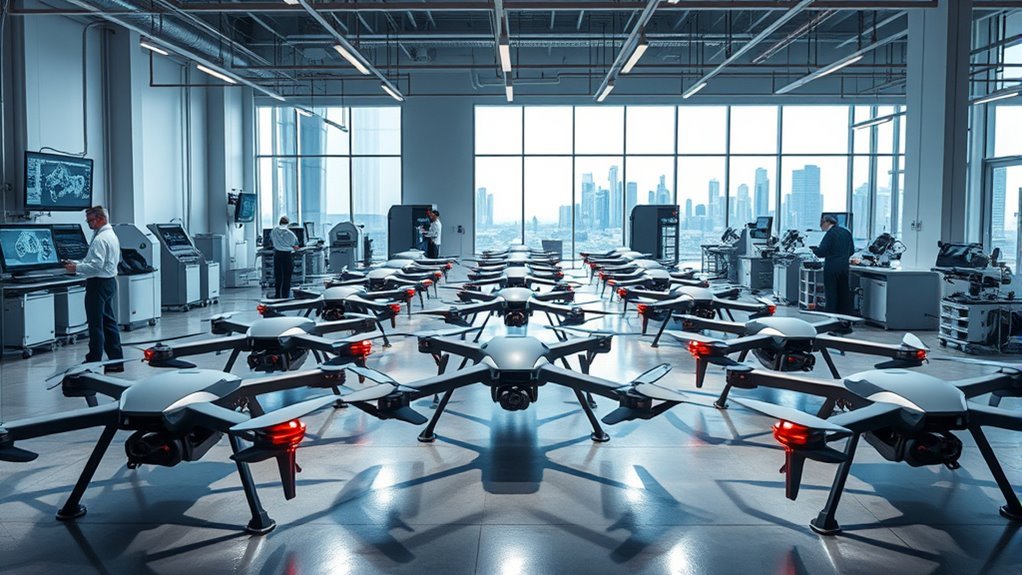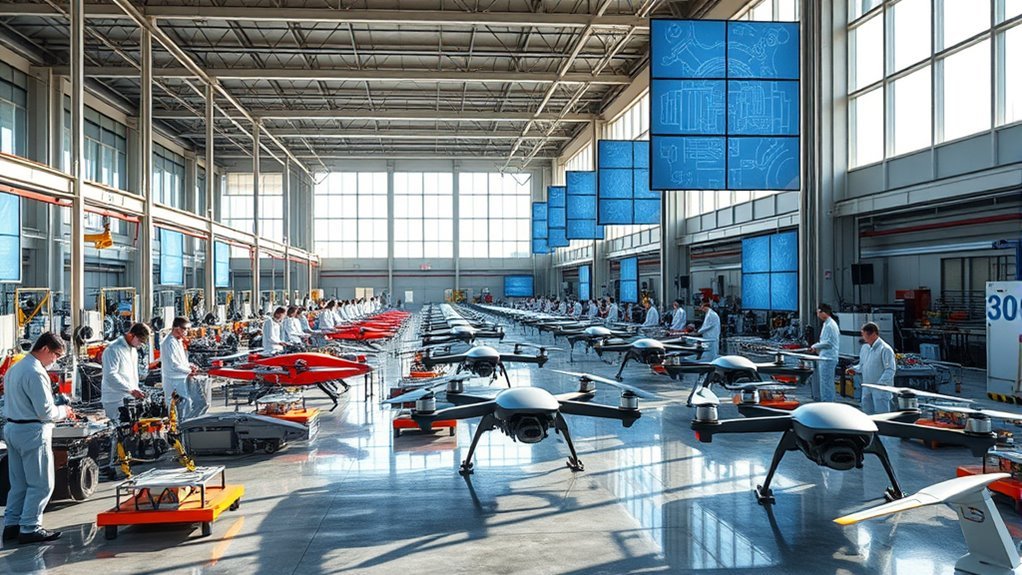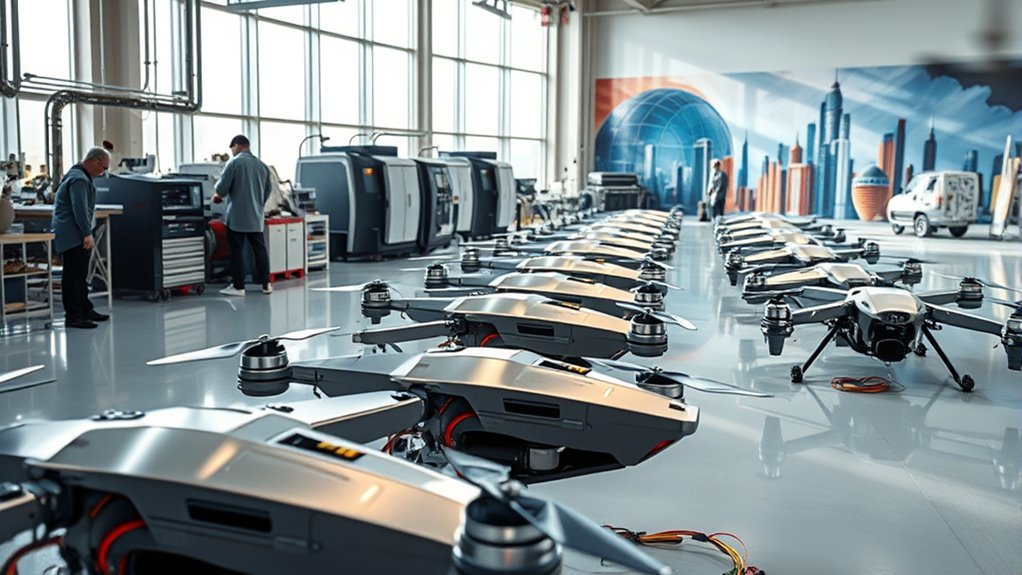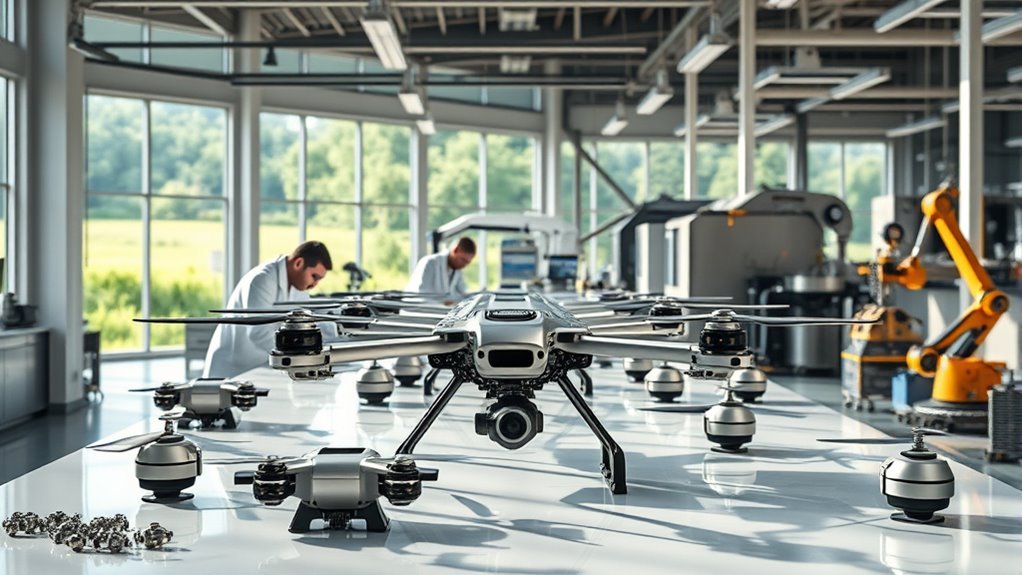Exo Drones are primarily made in the United States, Germany, and China. Each location offers unique advantages: the U.S. excels in tech innovation, Germany guarantees precision manufacturing, and China provides cost-effective mass production. This collaborative ecosystem enhances responsiveness to market demands. Robust supply chains and reliable component sourcing play vital roles in guaranteeing quality and performance. As you explore further, you’ll uncover more about Exo Drones’ manufacturing processes and the factors driving their development.
The History of Exo Drones

While the concept of drones has evolved considerably over the years, Exo Drones stand out due to their innovative design and advanced technology. The history of Exo Drones reflects the broader trends in drone evolution, showcasing how industry innovations have shaped their development. You’ll notice that Exo’s early models focused on basic functionalities, gradually integrating sophisticated features like obstacle avoidance and enhanced battery life. These advancements not only improved performance but also expanded their applications across various sectors, from agriculture to surveillance. By prioritizing user experience and adaptability, Exo Drones have positioned themselves as a leader in the market. This commitment to innovation guarantees you’re equipped with cutting-edge tools that enhance your freedom and capabilities in the skies. Additionally, Exo Drones consistently integrate advanced stabilization technology to ensure smooth video capture, which is crucial for high-quality aerial photography. The integration of AI-driven stability in modern drones has further enhanced their reliability and control during complex maneuvers.
Key Manufacturing Locations

When exploring the manufacturing landscape of Exo Drones, you’ll find that several key locations play a crucial role in their production. Major regional hubs include the United States, Germany, and China, where advanced technologies and skilled labor converge. In the U.S., innovation thrives in tech-centric areas, fueling rapid development and global production capabilities. Germany, known for its engineering excellence, contributes precision manufacturing techniques, ensuring high-quality components. In contrast, China offers cost-effective mass production, leveraging extensive supply chains. These locations work in tandem to create a resilient ecosystem, allowing Exo Drones to adapt quickly to market demands. By understanding these key manufacturing sites, you can appreciate the intricate web that supports the freedom and functionality of Exo Drones.
The Design and Development Process

The design and development process of Exo Drones is a meticulously structured journey that integrates cutting-edge technology with user-centric principles. It begins with brainstorming sessions that prioritize design innovation, leading to prototypes that must overcome various development challenges. Notably, the process emphasizes advanced camera capabilities, ensuring that the final product meets high standards for visual quality. Additionally, understanding signal attenuation is crucial for optimizing the drone’s performance in various environments, as it directly influences communication and data collection.
| Stage | Focus Area | Key Outcomes |
|---|---|---|
| Conceptualization | User Needs | Initial Design Specs |
| Prototyping | Functionality | Working Models |
| Testing | Performance | Data-Driven Feedback |
| Finalization | Production Readiness | Market-Ready Drones |
This table summarizes the stages you’ll navigate, ensuring that each phase is aligned with both user freedom and technological advancements, ultimately leading to drones that are both innovative and reliable.
Quality Control Measures
When it comes to Exo drones, understanding quality control measures is essential. You’ll find that manufacturing standards, rigorous testing procedures, and certification compliance play significant roles in ensuring reliability and performance. Each aspect contributes to maintaining the high standards necessary for advanced drone technology.
Manufacturing Standards Overview
Although Exo drones are designed to meet high-performance benchmarks, the manufacturing standards employed during their production play a crucial role in ensuring quality and reliability. These standards integrate manufacturing innovations and sustainability practices, minimizing environmental impact while maximizing efficiency.
| Standard Category | Key Focus | Implementation Method |
|---|---|---|
| Quality Assurance | Defect Reduction | Continuous Monitoring |
| Material Sourcing | Eco-friendly Materials | Certification Requirements |
| Process Optimization | Efficiency Gains | Lean Manufacturing Techniques |
Testing Procedures Implemented
Five key testing procedures are implemented in the quality control measures for Exo drones, guaranteeing that each unit meets stringent performance criteria before reaching consumers. First, a functional test assesses drone functionality under various conditions, verifying essential components. Next, performance evaluation includes flight tests to gauge stability, responsiveness, and range. Third, environmental stress tests simulate extreme temperatures and weather to assure durability. Fourth, battery efficiency tests measure charge cycles and operational longevity, critical for extended use. Finally, a final inspection confirms compliance with all specifications. Together, these procedures guarantee that each drone not only meets but exceeds consumer expectations, empowering users with reliable and high-performing technology in their hands.
Certification and Compliance
Quality control for Exo drones extends beyond rigorous testing procedures to encompass a thorough framework of certification and compliance. You’ll find that adherence to regulatory frameworks is essential; these rules guarantee that every drone meets safety and performance standards. Compliance certifications act as proof of the quality and reliability of Exo drones, providing you with peace of mind. Each drone undergoes assessments aligned with national and international regulations, guaranteeing they’re ready for various operational environments. This rigorous process not only enhances the drone’s marketability but also empowers you, the user, with confidence in its capabilities. Ultimately, these measures safeguard your freedom to explore while guaranteeing safety and reliability in your aerial adventures.
Supply Chain and Component Sourcing
As Exo Drones continue to gain traction in the market, understanding their supply chain and component sourcing becomes vital for evaluating their performance and reliability. A well-structured supply chain guarantees that these drones are made with high-quality components sourced strategically. Here are some key aspects to reflect on:
- Component Suppliers: Identifying reliable suppliers is essential for quality assurance.
- Sourcing Strategies: Effective strategies can minimize costs while guaranteeing timely delivery.
- Material Quality: The choice of materials directly impacts durability and performance.
- Global Logistics: Efficient logistics streamline the supply chain, reducing delays and enhancing integration. Additionally, the durable construction of Exo Drones contributes significantly to their performance and user satisfaction.
Future Trends in Drone Manufacturing
While advancements in technology continue to shape various industries, drone manufacturing is no exception, poised for significant transformations in the coming years. You can expect a shift towards the use of sustainable materials, as manufacturers endeavor to reduce environmental impacts and comply with evolving regulations. This focus on eco-friendly practices not only aligns with consumer values but also fosters innovation in material science. Additionally, brand innovations will revolutionize production processes, enabling faster assembly lines and higher precision in drone manufacturing. These innovations can lead to lower costs and improved product quality, giving you more options in the market. By embracing these trends, the industry can enhance efficiency while remaining committed to sustainability, ultimately benefiting consumers and the planet alike. Furthermore, as seen in the range capabilities of drones like the DJI Light Show Drone, the push towards advanced technology integration will likely continue to drive the evolution of drone manufacturing.
Frequently Asked Questions
What Is the Typical Lifespan of an Exo Drone?
The typical lifespan of an Exo drone varies, but with proper drone maintenance and regular battery replacements, you can expect around three to five years of efficient operation, maximizing performance and ensuring freedom in your aerial explorations.
How Do Exo Drones Compare to Competitors?
When comparing Exo drones to competitors, you’ll find they often exceed industry standards in drone technology. Their superior durability and innovative features provide you with greater freedom and reliability for various applications, enhancing your overall experience.
Are Exo Drones Customizable for Specific Needs?
Yes, Exo drones offer extensive customization options to meet diverse user requirements. You can tailor features like payload capacity, flight duration, and software capabilities, ensuring the drone aligns perfectly with your specific operational needs and preferences.
What Is the Average Cost of an Exo Drone?
When considering drone pricing, the average cost of an Exo drone can vary considerably based on features and specifications. Staying informed about market trends is essential to make a wise investment that aligns with your needs.
Do Exo Drones Require Special Licenses to Operate?
If you long for the thrilling freedom of flying an exo drone, you’ll need to navigate drone regulations first. Licensing requirements vary by location, so check your local laws to soar responsibly and legally.

